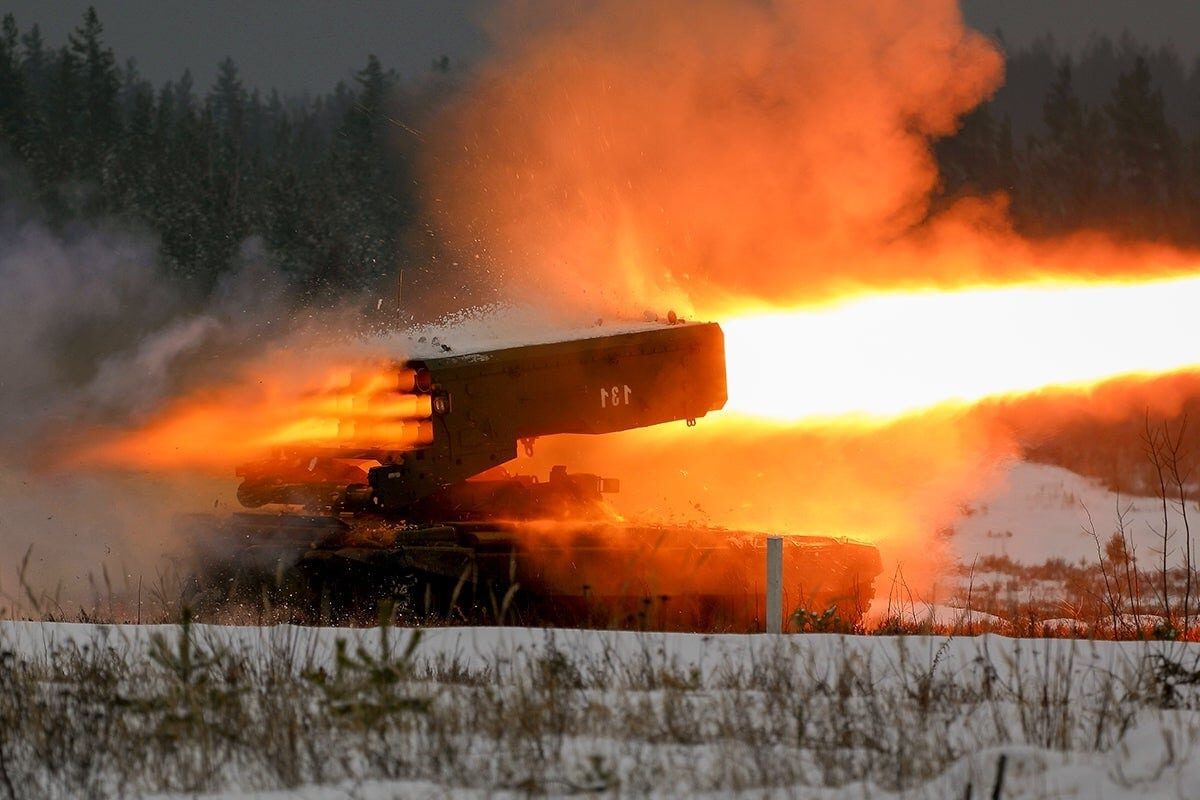This week, videos depicting the Russian military’s deployment of the TOS-1A multiple rocket launcher have been widely circulated. These large-scale bombardments of Ukrainian forces indicate an escalation in Russia’s offensive strategy in invading its southwestern neighbor. While Russian forces have been able to take much of Luhansk, Ukraine has firmly held most of Donetsk.
The TOS-1A is likely being used by Russian forces to break Ukraine’s fortified positions in the East and advance further into Donetsk.
TOS-1A: How Does it Work
This devastating weapon, known as a “vacuum bomb,” disperses gaseous clouds of chemicals in the air which creates a vacuum that, when reversed, causes a significant ripping effect on soft materials – including human lungs. This weapon is a powerful way to clear out buildings, field fortifications in bunkers, and is extremely effective against entrenched personnel. The introduction of this weapon in Russia’s invasion of Ukraine could be a turning point in the conflict.
A thermobaric weapon is a high-heat, high-intensive explosive. While other explosives use fuel/oxidizer premix, thermobaric weapons use nearly 100% fuel. The thermobaric weapon’s makeup makes its explosions much more powerful and bigger than its counterparts. Since these weapons use an oxidizer premix, it cannot be launched underwater, in rainy weather or at high altitude. These weather and environmental limitations, however, do not underpin the weapon’s devastating consequences when utilized. This weapon is an extremely effective tool against hardened targets, including bunkers, trenches and buildings, since its aerosolized fuel mix flows over, around and under obstacles prior to its detonation. In other words, the weapon is not deterred by physical barriers.
According to the 2011 edition of U.S. Army Training and Doctrine Command’s unclassified World Equipment Guide, “The primary … effect [created by the TOS-1’s rockets] is a long-duration high-pressure blast wave which creates a vacuum – then precipitates a reverse wave. These pressure/vacuum surges (up to 427 pounds per sq inch) cause a ripping effect on soft materials (such as airplane skin, radar surface, human lung tissue). Walls and surfaces within the affected area do not necessarily shield victims, rather cause multiple pressure waves, which amplify the tearing effects and can topple structures.”
Russia’s TOS-1A system has roots in the TOS-1 system created during the Cold War. The newer variant entered service in 2001 and hosts a litany of advanced modifications based off its predecessor, including an upgraded ballistic computer and improved range. Its range extended to 6km initially, and now exceeds 10km. Russian forces currently employ several different thermobaric weapons and delivery systems ranging from shoulder-mounted RPG variants to rocket artillery munitions.
russian TOS-1A shelling Ukrainian positions near Novomykhailivka, Donetsk region. This is what the the largest and most horrific war of the 21st century looks like. Ukraine is ready to strike back. To do this, we need NATO-style MLRS. Immediately. pic.twitter.com/XwdBfAfEq8
— Defence of Ukraine (@DefenceU) May 26, 2022
Since its inception, the TOS-1A has been used by Russian and Syrian forces in counterinsurgency operations in 2016 and in the Nagorno-Karabakh conflict between Azerbaijan and Armenia in 2020. Several confirmed sightings of the TOS-1A weapon have been verified in Ukraine. In recently circulated videos on social media, large shockwaves can be seen in the Donbas regions following the employment of the TOS-1A weapon.
While no law currently exists that bans the use of these rockets in combat, their devastating effects are considered by some analysts to merit the title of a war crime.
Maya Carlin is a Middle East Defense Editor with 19FortyFive. She is also an analyst with the Center for Security Policy and a former Anna Sobol Levy Fellow at IDC Herzliya in Israel. She has by-lines in many publications, including The National Interest, Jerusalem Post, and Times of Israel.

